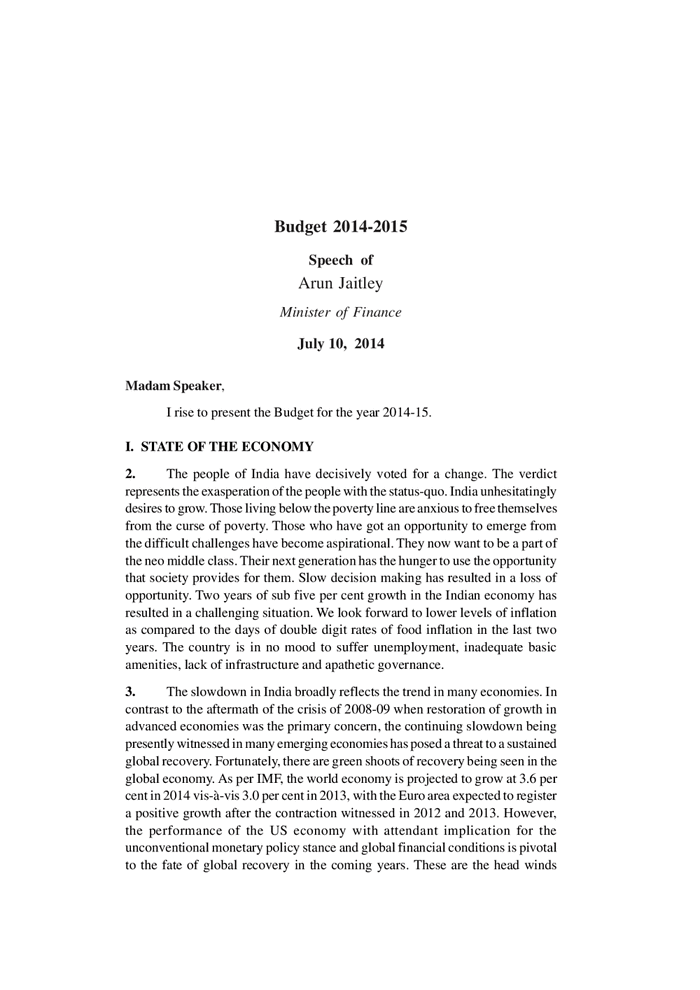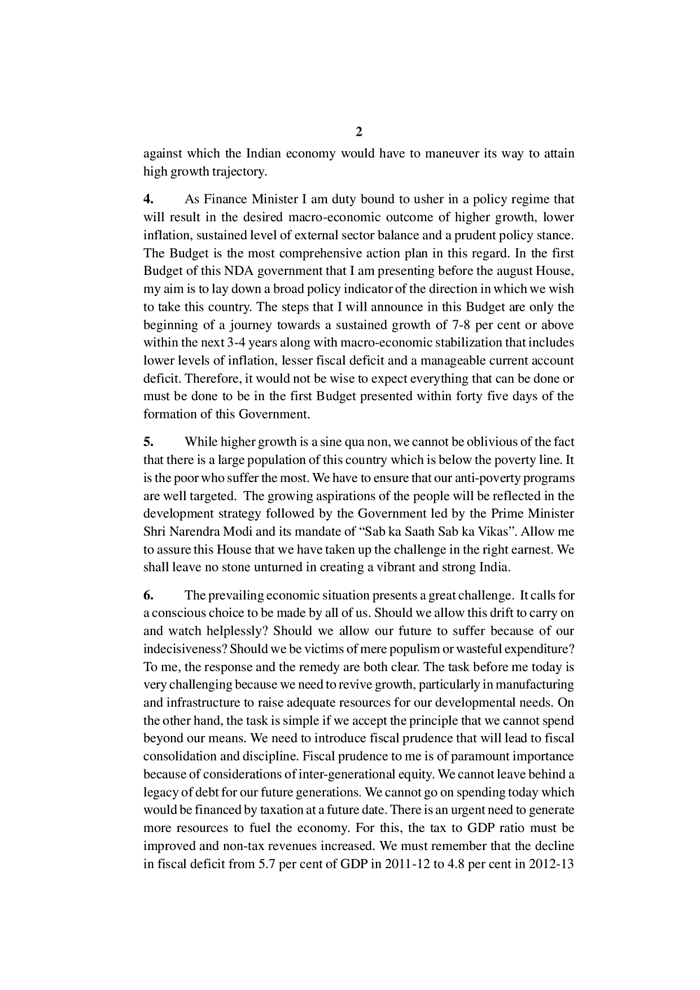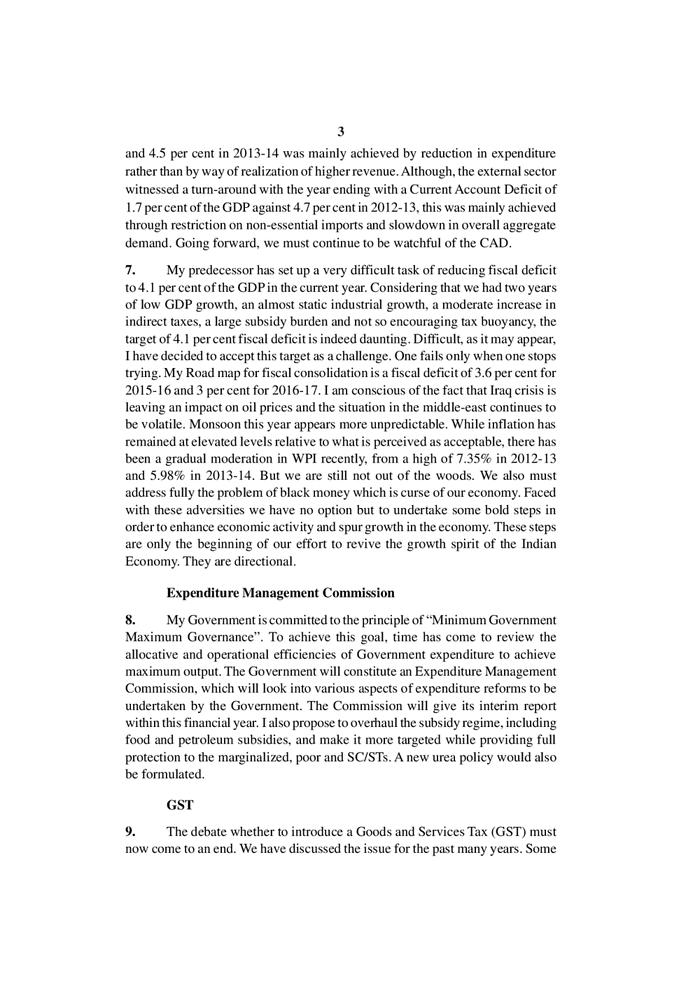 By Madan Sabnavis FB 11 July 2014
By Madan Sabnavis FB 11 July 2014
In what must be one of the longest Budget speeches which goes on for 43 pages, the finance minister has not quite presented a revolutionary set of proposals as was expected by the market but focused on fiscal prudence and gradual movement towards the 3% fiscal deficit ratio. This does appear to be the starting point; and the numbers have been worked around it. The fiscal deficit ratio has been retained at 4.1% of GDP with the caveat that this would be challenging.
The FM has alluded to the strategy followed by earlier governments to achieve the target by cutting down on discretionary spending. Hopefully this may not have to be done this time. For this to happen, the nominal GDP growth rate of 13.4% assumed must be achieved. Based on their own assumption of GDP growth of 5.4-5.9% in the Economic Survey, inflation may be expected to be around 7.5-8% for this to materialize.
What is the macro economic impact? First, the Budget will have a positive impact on growth based on the government’s own spending of Rs 1.07 lakh cr on capex not being compromised during the year and the other investments taking of as anticipated based on the various programmes announced. Given that there are eight months to implement these schemes, the impact will however be minimal in FY15. But an initial push can be provided.
Second, an attempt has been made to lower inflation through selective tax cuts. Given that food inflation is the major concern, over which the Budget has limited impact, it is unlikely to make a major dent here. Also the fuel subsidy has remained unchanged and while there is talk of better structuring, with elevated global crude oil prices, this could mean some additional pressure on inflation. Probably that is why the GDP (nominal) growth assumption of 13.4% takes in a high inflation number.
Third, investment will definitely get a boost though the various focus projects spoken of in terms of roads, new cities, warehousing, etc, will be only partly met in FY15. Add to this the investment allowance for companies which invest more than Rs 25 crore, and there could be a positive overall impetus. The only militating factor for this to work out would be the existence of spare capacity with industry and high interest rates in the face of low demand conditions.
Fourth, an attempt has been to boost savings by increasing the amount of savings under Section 80C. Simultaneously one is allowed to put now Rs 1.5 lakh in PPF. Given that there is limited scope in terms of number of schemes under this section, funds would move towards insurance and PPF. However, the government does not expect more than Rs 2000 cr to accrue through this source, which means that the impact will not be really sharp. In fact, by making FMPs taxable under short term gains, savings which hitherto went here could move out to gold or equity, which will impact productive financial savings.
Fifth, the Budget has spoken about making agriculture more robust, but that appears to be more in the medium term as issues like having a national market and repeal of APMC laws has been on for quite some time now with few states really taking action. There has been a commitment made to grow this sector by 4% per annum, though the route has not quite been explained. This is a concern as agriculture is in the private sector and the government can only be an enabler. The measures announced may not be able to mitigate the ill effects of an adverse monsoon this year.
Sixth, the capital market expected some major changes like the reduction or abolition of the Securities Transaction Tax (STT). However, this has not quite happened and the focus is really now on sentiment being furthered by better economic performance. Also the fact that the government has not given up its prerogative on retrospective taxation is significant as it does dampen to an extent the enthusiasm in the market. This was one reason why the Sensex dipped during the announcement of the Speech though it recovered after the other announcements were made.
Seventh, the fiscal deficit has been retained at 4.1% which means that the borrowing programme too would be around Rs 6 lakh crore as in the Interim budget. This number is important as it means that the pressure on liquidity will not change and interest rates, especially GSec yields will remain stable and guided more by RBI policy action during the course of the year.

Image: Thinkstock
Eight, the disinvestment target this year is around Rs 60,000 cr which is again audacious considering that even in the last couple of years the government has targeted such high amounts but has not quite garnered the same. In fact, we have not seen genuine disinvestment of this magnitude and more often the programme is partially completed by getting PSUs to invest in each other’s equity. The positive factor is that the capital market has been robust for some time driven by sentiment, which can support such programmes provided the sentiment remains as any significant change in macro fundamentals will be only gradual.
Nine, the banking sector has been told to fend for itself when it comes to capital, which is a good signal because it serves a dual purpose: banks find their own funds for capitalization and the government does not have to make such provisions. The challenge for public sector banks will be to raise this money for which they need to get their books in order as their NPAs are high as are the restructured assets, which have to be brought down to get better valuations in the market. Banks have also to be allowed to borrow long with CRR and SLR concessions so that they can lend to infra projects at lower rates. This will be beneficial for the borrowers.
Tenth, the big bang reform was to be in the area of subsidies. The overall amount has been left virtually unchanged with that on fertilizers moving up marginally. There has been some talk on restructuring them, but it looks unlikely that a solution can be found in the immediate run. With inflation high and threatening to increase due to a weak monsoon and high crude oil prices, any reduction in subsidy would mean higher inflation, which is not advisable. But, it would be interesting to see any changes in the policy of disbursal of subsidy.
On the whole the FM has done a good job working through the constraints, and tried to give incentives wherever possible and allocating funds where necessary. There has been no deviation as such from earlier budgets but a modicum of continuity has been preferred. It may be assumed that if the government is able to successfully implement this Budget, it could bring in the necessary reforms in the next one, when the macro conditions are hopefully better and a consensus reached on DTC and GST. This exercise would on the whole score 7 out of 10.





